Sujata Massey's Blog, page 12
April 8, 2020
Glorious Gargoyles! A Chat with Gigi Pandian
This post originally appeared on Murder Is Everywhere.
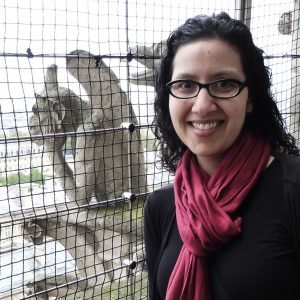
Continuing our journeys to Paris, I’m interviewing author Gigi Pandian about her new book, The Lost Gargoyle of Paris. Gigi has been a friend of mine since the time she was writing her first mystery featuring archaeologist Jaya Jones. She grew up as the daughter of anthropologists from New Mexico and South India and spent her childhood traveling the world with them for research. Those adventures built the imagination that created the Jaya Jones mystery series, followed by the Accidental Alchemist series, and many locked-room short stories. Gigi has won Agatha and Lefty awards for her fiction and made it to the USA Today bestsellers’ list. The Alchemist’s Illusion, published in 2019, is a finalist for the GP Putnam Sons’ Sue Grafton Memorial Award, which we’ll learn about on Edgars Night, April 30. Yes, I’m also competing for the same award, but I’ll happily lose to Gigi.
I was thrilled that Gigi could join us to talk about her latest Accidental Alchemist mystery, a novella titled The Lost Gargoyle of Paris. It was released last week and is an immensely cozy, comforting read for me during these difficult times.
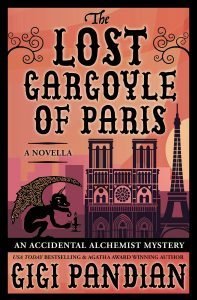
Thank you for inviting me back to Murder is Everywhere, Sujata. I hope everyone is doing well in these difficult times! It’s great to see everyone remotely, from my cozy little house in Northern California where I’ve been sheltering in place for four weeks now.
Tell us a little about your new book, and especially its connection to Paris.
The Lost Gargoyle of Paris is a novella in my Accidental Alchemist mystery series about a centuries-old female alchemist Zoe Faust and her impish gargoyle sidekick Dorian Robert-Houdin. I hadn’t planned on writing a novella set in France before the next full-length novel, but the idea came to me after watching helplessly as Notre Dame Cathedral caught fire in April of 2019.
Both Zoe and Dorian’s histories are connected to the cathedral, so I found myself unable to focus on their next adventure set in Portland, Oregon. I knew they had to go on an excursion back to Paris first. Like all of my books, it’s a lighthearted puzzle plot mystery steeped in history.
In The Lost Gargoyle of Paris, Zoe and Dorian travel to Notre Dame Cathedral in Paris to investigate a mysterious discovery found in the wreckage of last year’s tragic fire: a long-lost gargoyle illustration drawn by Victor Hugo himself.
American secret alchemist Zoe narrates the novel. Her Dr. Watson figure is Dorian. He’s the most extraordinary sidekick imaginable. What’s his bio?
Dorian would definitely take issue about being called a Watson rather than the hero! He thinks of himself as a modern-day Poirot—and as a gargoyle, he has the “little gray cells” to make him convinced of his brilliance.
Dorian Robert-Houdin is a gargoyle who was originally carved in stone for Notre Dame Cathedral in Paris, but was accidentally brought to life through alchemy. He was a prototype who was just a little too small, at three-and-a-half-feet, so architect-restorer Viollet-le-Duc gifted the cast-off carving to his friend, famous French stage magician Jean-Eugène Robert-Houdin. The magician didn’t realize an antique book he was using as a stage prop contained real magic until it brought his carving to life. He raised Dorian in secrecy, teaching him to be a proper Frenchman.

I am a gargoyle lover—there are so many gargoyles and whimsical animals built into the grand stone buildings of old Bombay, and I’m always trying to photograph them. Was there a special time that gargoyles were in architectural fashion worldwide? Besides England, India and France, where else were gargoyles adored?
True gargoyles are water spouts, but the term “gargoyle” has come to be used more broadly for all sorts of animal grotesques. Gargoyles can be found in ancient Egyptian and Greek architecture, but they’re most associated with medieval European cathedrals. But there’s a mystery that scholars disagree about. What were they meant to represent? Were gargoyles meant to be demons who would frighten people into attending church? Did they represent the trapped souls of people who’d been wicked on earth? Or perhaps to ward off evil themselves?
By having Dorian a living, breathing character, you’ve woven a little magic realism into cozy mysteries. How has that been received by the reading audience?
When I created Dorian, I didn’t imaging it was for anyone beyond myself. I was 36 years old and had just been diagnosed with breast cancer. I had a year of cancer treatments ahead of me, so I threw myself into writing something meaningful to me. I’ve always found gargoyles to epitomize all things mysterious, and have been fascinated by them since I was a kid, so I created a gargoyle character to amuse myself. (And of course my subconscious had kicked in and had me create an alchemist who’d discovered the Elixir of Life, while I was going through chemotherapy.)
I’ve been surprised at every step of my publishing journey how much readers love Dorian and Zoe’s cozy world of alchemy. From my agent and editor to the enthusiastic readers who made the series a success, I’m still pinching myself.
Do you draw the covers for the Alchemist series? If so, what is your art background?
I do have a background in art, but illustrator Hugh D’Andrade is the talent behind the amazing illustrated gargoyle image. In a funny coincidence, Midnight Ink hired him to illustrate the book covers, not knowing that he’d been one of my instructors in art school!
You have a career that is sometimes called a hybrid: some of your books are published by traditional presses, and some, like this current book, are self published. What advantages does this give you?
I’ve learned so much about publishing through the various ways my books have been published. I’ve been able to see firsthand the challenges of different types of publishing—not just self-publishing versus traditional publishing, but also what it’s like to be published by presses of different sizes.
I began my career self-publishing after my agent had been pitching my debut mystery for a year and kept hearing that marketing departments weren’t sure what do to with my books. It was a rewarding experience but a lot of work, so I was happy to be picked up by publishers after my debut novel novel did well. When the large publishing house that published my Accidental Alchemist mysteries closed their mystery imprint, I knew I wanted to continue writing the series and that my readers wanted more books, so I decided to publish the series on my own (and happily I was able to buy the gargoyle illustration so I can continue to use it). It’s an in-progress experiment that I’m having fun with, but I’m not sure what the future holds.

How’s quarantine going for you? What are some of your stress-beating tips for us?
My agent is patiently waiting for a project I owe her, but I’m finding it so difficult to focus these days! But I’m very fortunate to have a house full of books and a small but beautiful backyard vegetable garden.
I had an online video meet-up with my writer’s group last week, and that helped me see I wasn’t alone in having trouble focusing on writing, so I’m not being too hard on myself.
The things that are helping most with stress are staying connected to my distant loved-ones, cooking, and getting plenty of exercise. I love to cook and already cooked most of my meals at home, so I’m making a point to experiment with more recipes while I have additional time at home. I’m the cook and my husband is the gardener, so we each get the benefits of both. Personally I think I got the better end of the bargain.
Sending good wishes to everyone! I hope you have many fulfilling armchair travels this spring.
Get a free Jaya Jones eBook download and recipes by signing up for Gigi’s newsletter and say hello to her on Facebook.
The post Glorious Gargoyles! A Chat with Gigi Pandian appeared first on Sujata Massey.
March 25, 2020
My Quarantine Smells Like Jasmine Rice
This post originally appeared on Murder Is Everywhere.
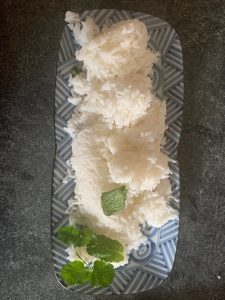
Scents that jolt our memories are important because we rarely smell them anymore.
Think about that for a moment.
I can still summon the soothing aroma of the Nivea lotion I used during my sixteenth summer. And the piquantly fruity smell of Haribo Gummi Bears, my favorite snack at summer camp. If I smell boiled cabbage, I step back into the hallway of my late grandmother’s home in Germany. And it’s only in India that I can inhale a particular mix of diesel, wood and spices.
I am staying home, probably for a month or two, and I wonder whether there will be a scent from these days that will become a permanent reminder in my olfactory brain.
It is hard to identify the everyday smell of your own home, although anyone who visits you probably has noticed it. I can only smell a change in my environment, and these days, that is the smell of freshly cooked jasmine rice.
Before the quarantine, my go-to rice was basmati, a long-grain rice that originates in South Asia. I buy a 20-pound bag imported from India every 9 months or so from Sam’s Club. The rice supply inside my home bag was running low this winter, and I was too busy to replace the bag before I realized I really needed more.
When the virus began to spread in Baltimore, I had no desire to rush to a warehouse store to look for Royal Basmati Rice along with thousands of other panicking people. Instead, I hurried through jammed neighborhood supermarkets and a gourmet grocery stores. It was Friday the 13th, and the stores were out of lots of staples, including basmati, arborio, and long grain rice. All that was left on the shelves were small bags of sushi rice, and jasmine rice. Jasmine is a medium-length grain that is slightly moister than basmati, but still has enough of a presence that it plays well with Indian curries, and many other dishes.

Jasmine rice is grown in Thailand, Cambodia and Viet Nam, and probably would not be as delicious if people tried to grow it elsewhere. I love this rice varietal’s sizable grain that, when it’s steaming, fills the air with a sweet, almost jubilant aroma. Some say it smells like a combination of a fruit called pandan… and popcorn. Interestingly, jasmine rice doesn’t have a biological relation to the Asian flower, although the jasmine flower’s tiny white blossoms are used often for religious ceremonies also has a powerful smell.
In The Sleeping Dictionary, I wrote about the rice troubles of 1943, when the rice farmed in rural Bengal was shipped out to the troops in such great quantities, that there was not enough left for Indians. About 3 million Indians, mostly Bengalis, died of starvation in the Rice Famine. The wealthy in India hoarded rice in 1943 just as people are hoarding hand sanitizer and toilet paper today. And when the poor flooded Calcutta, begging for food, aid workers had to feed them rice cooking water, because rice itself was too much for their abused stomachs to manage.
Rice is once again a war-time food; a very thrifty, filling and versatile way to keep feeding a family that cannot go shopping. Potatoes go green, bread gets hard and sometimes moldy, but rice perseveres.
People are sometimes afraid to cook rice, but it’s truly very easy.
I’ve cooked jasmine rice straight out of the bag, throwing it unranked in the rice cooker with the prescribed amount of water. You get the best result if you rinse it really well, though, with a few changes of water, before starting to cook the drained, slightly softened rice with a quarter teaspoon of salt, or to taste.

If you don’t have a rice cooker or InstantPot, it’s a cinch (and faster) to add one cup of rice to a hot saucepan on the stove with a little oil on the bottom. Stir for a half minute and pour in one and a half cups of water and the aforementioned salt. When it comes to a boil, put a lid on and change the heat to low-medium. Check in ten minutes or so, and if the water is almost gone, turn off the burner and let the steaming finish. Add a half-cup more water if you want your rice really sticky! If you double the amount of dry rice to two cups, use three cups of water.
I think the sticky/starchy characteristic helps jasmine rice hold its own nicely in the refrigerator for up to a half week—when basmati really gets nasty after more than two days.
I am striving not to throw away uneaten food during this quarantine period, but to repurpose it and eat it swiftly, so I am very happy I wound up with a big bag of jasmine rice. I use my refrigerated leftover rice. I also use it with other ingredients in fried rice and biryani. I could do a rice pudding, or a casserole as well. Rice of any sort freezes well and can be reheated from frozen in a hot pan or the microwave.
I have about eight pounds of jasmine rice, having cooked it about four times so far during the isolation period. I hope it holds out for however long I’m here. The memory of Asia wafting from the rice cooker reminds me of so many happy restaurant meals and far-flung travels. Right now, rice promises me that the world will go on.
The post My Quarantine Smells Like Jasmine Rice appeared first on Sujata Massey.
March 11, 2020
Hands Together, With Hope
This post originally appeared on Murder Is Everywhere.

Okay, I realize there have already been a few MIE posts about this.
But when Donald Trump posted a meme of himself fiddling while Rome burns, I could not refrain from comment.

Not only were Trump’s words and image in bad taste, but his comment appeared to mocking the efforts by individual state governors and public health workers to protect their citizens from the coronavirus (since there is no serious federal response from the US government).
Fortunately, scientists are sharing wisdom about a technique called social distancing. May I expound?
The strategy of social distancing is that with some behavior changes, we will undoubtedly slow the epidemic and save thousands of lives. What is social distancing, you ask?
This doesn’t mean snubbing your neighbor at the potluck or ignoring text messages. It doesn’t mean staying in your house alone. It does involve avoiding large group gatherings like conventions or rallies. These are spots where you could encounter virus droplets which you then might pass to others. The reality of social distancing is quite hard, if you’ve booked a space and contracted vendors. Less than a week before is onset, the organizers of the Tucson Book Festival cancelled their event, which draws thousands, for the public good. It’s also the reason that colleges are doing by telling their students who are going off on spring break to self quarantine for two weeks before returning to the classroom. The kids might think it’s an endless party, but it gives a bit of space to letting them get through their potential illnesses and/or contamination potential.
In my daily life, the first directive of social distancing is to stop shaking hands and hugging.
This got me thinking about the basics of superficial human touch—touch toward colleges, strangers and friends that is considered standard etiquette to initiate or receive.
When I lived in Japan, handshaking was only done at the insistence of zealous foreigners. Bowing was so much easier; self contained and respectful. It’s also the preferred greeting in Korea, but not in China, where people nod, applaud, or more recently, shake hands.
South Asians also offer hospitality without touching. Adaab, meaning “respect,” is a secular verbal salutation between Hindus and Muslims that includes raising one’s right hand towards one’s own face with the palm inward, and a slight bow. The movement is elegant and humble.
Buddhists and Hindus share an iconic gesture called the Anjali Mudra with hands pressed together before the chest. You can raise the hands slightly toward the face to show extra respect. Hindus might add the utterance, “Namaste,” which means “I salute you” and can mean both hello and goodbye. In the west, folded hands looks like a prayer. That’s OK. We need all the prayers we can get.
While recently in India, I found myself making the Anjali Mudra toward people I was meeting, especially elders. Before, I’d felt this movement was too foreign for the United States, but my feelings are changing. I yearn to offer people a sign that I am greeting them with affection, without abandoning my commitment to social distancing.
Last Sunday I walked to our Quaker Meeting—to the early worship hour, which I knew would have less than 20 worshippers. I pushed open the heavy wooden door to the building and was greeted with the Anjali Mudra by one of the ushers, a young man who is of European-American descent. I was stunned—but recalled that I’d received this greeting from another American too, within the last few months. And at the end of meeting, we did not shake hands—but we smiled.

That’s not the end of the story, though.
Another hand movement is gaining traction. It’s the split hand Vulcan greeting created by actor Leonard Nimoy for Star Trek. Mr. Nimoy told The Forward that, in his childhood, he was inspired by the powerful gesture of blessing performed by a rabbi toward his congregation. It stayed with him all the way to outer space. And George Takei, the brilliant actor who played Sulu, has commented this is the obvious greeting for our crisis.

So why not bring it back to earth?
The post Hands Together, With Hope appeared first on Sujata Massey.
February 27, 2020
An Adventure on Pali Hill
This post originally appeared on Murder Is Everywhere.
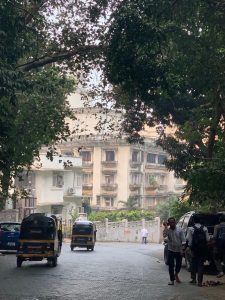
The first welcome I had in Pali Hill was from a rooster.
I’d just entered my bedroom in the Airbnb rental. It was about three-thirty in the morning. As I put down my suitcase, exhausted after eighteen hours of flying and lots of airport waiting, a series of mournful squawks began. The glass window was latched shut; it was January, with evening temps in the sixties. But the valiant rooster’s cries carried, despite the earplugs I’d brought on suggestion from the host and previous Airbnb guests in the review.
You may wonder why I decided to stay in a flat where I knew a rooster made an impact. The answer is two-fold. First, I thought the rooster would just wake me up a little early in the morning. And the second is that I really wanted to stay in a residential neighborhood of Mumbai with a local host, rather than a hotel. I am willing to try new things, because I’d rather stay in the real world.
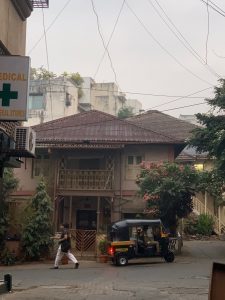
But is Pali Hill, a posh historic neighborhood within the area known as Bandra West, the real world? Plenty of people would say no—it is too elite and full of many people of different countries and faiths. It is far more mixed, and liberal, than a typical Indian community.
I was a temporary visitor, so I am not a Pali Hill expert, let alone one on Bandra itself. The larger village known as Bandra (Vandre means port in Marathi) began as a fishing village. Its identity was stamped in terms of architecture and a grand Catholic Church, during the Portuguese colonization. The British took over, and the new buildings that went up—charming bungalows and flats—were home to wealthy Parsis, Anglo-Indians, and others with the taste for quiet living in the hills north of Bombay. In the 1930s, film people began settling here. Today there are splashy new shopping areas with crowded streets, but most in bungalows and apartment buildings that were grand in the 1920s and are faded-grand today. The simpler places are still locally owned and many are rented to the French and other international residents.
Some grand houses that aren’t occupied are held close by the owning family and rented for use as film sets. Many homes are guarded by high walls with signs proclaiming stern statements such as: “This is the home of the Perreira Family. Absolutely no trespassing upon penalty of law” or “This home belongs to J Winslow and family. It is not for sale and do not enquire about it.”

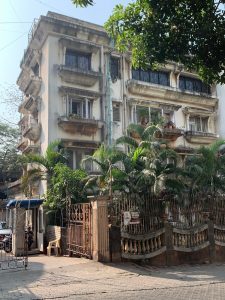
Keeping one’s hold of property in Mumbai is not always easy. A charming sky-blue cottage across from my favorite coffee place is titled to an elderly couple. They traveled for a few months and left the property in the hands of a servant who promised to take good care. When the couple returned, the locks had been changed and the servant had taken over the house, refusing them entry… saying the house was now his. Because of the city’s rules affirming the rights of people to stay on properties where they’ve had a history of living, the servants may trump the owners in this contentious case that has Pali Hill neighbors talking.
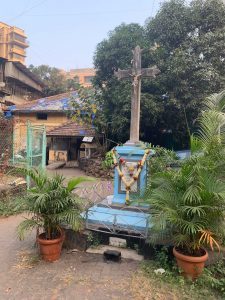
Back to the names on the cottages. Many of the names are Portuguese ones like Almeida, Pereira, and Braganza. It turns out that the Catholic community in Bandra is quite different ethnically from the Christians of Goa, Kerala and other areas. Bandra and the villages around it like Santa Cruz were home to a very old Marathi speaking community who lived in the area as farmers, fishing people and salt gatherers. They were converted to Catholicism during Portuguese rule in the 15th and 16th centuries. This is when they began taking Portuguese surnames, celebrating Christian holidays, and enjoying roasts and sausages.
Today, Bandra is a prime location to run a restaurant or cafe with high prices, offering sustenance to foreigners in search of almond-milk cappuccinos, as well as affluent young Indians wishing to have fun away from the prying gaze of their family and neighbors. A number of Airbnb listings for Bandra West state that “unmarried couples are welcome,” which would not necessarily be true throughout the city.
In The Widows of Malabar Hill, Perveen travels secretly to meet an attractive young man. The Bandra Bandstand area is where she experiences a burning kiss on the rocks close to the Arabian Sea. This business was inspired by the kind of hanky-panky that has been going on there for at least a century.
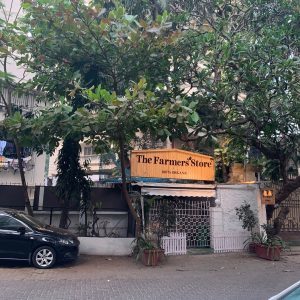

One of my favorite rituals while staying in Bandra was fitness walking in Joggers Park, a scenic park with greenery in the center of an oval track. Along one side, you can see the sea. The park is popular all day long with friends who come to walk together, or to do yoga and training exercises.

There was a series of oval tracks—one dirt, another stone, another brick, and so on. The youngest or fastest people usually moved on the outside track, while the old friends wishing to catch up could meander and stop on the old-fashioned walkways and take time to gossip sitting on benches.
Just like a beautiful Indian garden, the track has floral flourishes and a dramatic center point: garden with a bridge over a pond with ducks. And on its banks, to my amazement, was a cage holding a rooster and some chickens. This fellow was quieter than the one near me; perhaps because he had so much to look at around him.

The post An Adventure on Pali Hill appeared first on Sujata Massey.
February 12, 2020
Mary Higgins Clark, Speaking for Women
This post originally appeared on Murder Is Everywhere.
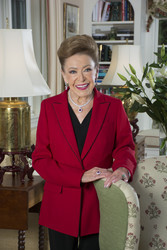
Mary Higgins Clark, Queen of Suspense
Literature became less suspenseful on January 31, the day that Mary Higgins Clark slipped out of the world.
Often called the Queen of Suspense, the 92-year-old author published more than 66 books in a forty-four year career. She was in Naples, Florida, working on a book when she passed away from complications of old age.
Mary was a native New Yorker who grew up in the Depression and suffered the loss of her father to heart attack while a young girl, and her husband to the same disease while she was raising their five children. That loss, however, did not result in the expected situation of her living out the rest of her days in hardship.
Mary’s tragedy put into motion the creative writing career she’d always wanted—to move from short stories to novels. She started out writing between 5 and 7 in the morning, then got her kids out the door, and then went by train from New Jersey into Manhattan to her office job at a script-writing company. When I think about how busy these workdays must have been, and then add on the five children in morning and evening, my head spins!
A lot is being said about the exemplary fortitude of Mary, and of her genius in creating a signature genre of domestic suspense novel that has exploded in the last few years.
But what I find most significant about Mary Higgins Clark is that she told secrets about women’s lives at a time that women were routinely silenced for their supposedly unimportant observations. Through her novels, Mary illustrated the wrongheadedness of the silencers, without seeming to be composing anything more than a vastly thrilling commercial novel.
After the breakout of her second book, Where are the Children?, MHC was able to write full-time. From that point on, every book she wrote was a national bestseller. Her longtime publisher, Simon & Schuster, estimates she’s sold more than 100 million books in the United States alone.
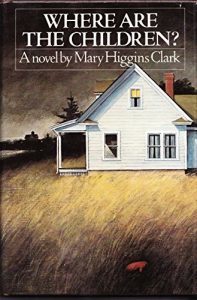
The original book cover in 1975
I first caught sight of a Mary Higgins Clark book at my local B. Dalton bookstore in the mid-1970s. I should have been in the children’s section, but had ventured over to adult mystery, because I had become a fan of Conan Doyle and Christie. Where Are the Children? had a book jacket showing an isolated house in a windy field, and you could tell a bad storm was coming. I quickly discerned the story’s premise was that children had disappeared and might have been killed by their mother. It seemed too much to handle. Now that I’m older and wiser, I’m sure Mary would have approved of the eleven-year-old me walking away from her blockbuster novel.
Recently, I listened to the audiobook version of Where Are the Children? Now that child abuse is not a huge cultural secret, there was a veiled child on the cover, making it even creepier.
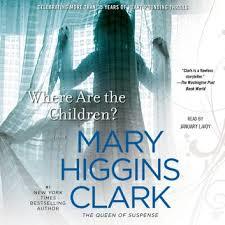
I found the most disturbing parts were the chapters narrated by the killer/kidnapper. I fast-forwarded during most of his narration. But there was a lot else that I took in to with fascination. She transported me back to my memories of the early 70s. It was a time that America was split between “squares” and “rebels.” You were either a Nixon fan or absolutely against everything he stood for. To say you supported equality for women meant you were a “women’s libber,” which was usually uttered as an epithet.
The novel’s flawed protagonist, Nancy Eldridge, is no “women’s libber.” She is a housewife admired by the Cape Cod community where she lived for her gentle ways with her children. Nancy is very private because she is mired in an earlier trauma. There is no talk of women’s liberation; she’s married to a dear man who wants nothing more to protect her, just as she believes her first husband did.
The trauma is shared with the reader early on. Nancy recalls her college-age marriage to a professor. When she had two young children, her health and memory began to fail and the children disappeared and were later found murdered. Nancy’s first husband, Carl, drowns himself in apparent grief when Nancy is charged with the children’s murders. She knows she didn’t kill them—but she doesn’t remember much about the time, and a witness claims she spoke of killing them. Nancy is released from prison on a technicality and leaves the country. Then, seven years later, when she’s remarried and living quietly on Cape Cod with a second husband and their two young children, they suddenly disappear on the morning of her birthday—which is also the anniversary of the earlier abductions. Nancy is sure they’ve been kidnapped and will be killed just as her first children were. She collapses. The police, after learning her past, think she’s their killer.
Nancy presents as a hysterical woman at a time when women were often considered hysterical and incapable of speaking for themselves. A psychiatrist using a truth serum is the key to uncovering what happened before, and he insists to the police chief that this might have bearing on the present crisis. The novel is packed with many paternalistic males, some of whom conspire to help Nancy, and others who suspect her. And there are three other strong women characters in the book, including a real estate secretary, a housewife and a grocery store owner, who are repeatedly shut down by the men around them. A very negative male character presented to the reader is a military deserter, a recognition of the country’s divided feelings about the draft.
While Mary Higgins Clark had something very important to say about how society hushed up women and children, including those who are wounded by sexual abuse, she always did it through the lens of popular fiction. She wrote the kind of book that conservatives would pick up and consider just an other exciting book. The feminism goes down easy, like the cup of coffee or glass of wine her heroine enjoys when she is feeling relaxed and safe.
As decades passed, the books piled up and the heroines became career women. At their sides were good men who might be community members, although an attractive young one would usually serve as a love interest. There were always strong women characters close by the heroine. These ladies are often older relatives or secretaries, and presented by the author with glowing recognition of their attractiveness, compassion, and insight. These women know something’s wrong—and they speak up.
MHC had every book become a bestseller and was celebrated as a Grandmaster by the Mystery Writers of America. But she’d seen over the decades, how mysteries starring men racked up Edgar awards while those featuring women as anything other than victims, mothers or girlfriends were scarce. Mary asked her publisher to assist her in establishing an award for mysteries about women. She had strict criteria for the award winning book’s protagonist. The character was to be a woman without professional crime fighting occupation, to be someone with mostly positive family relationships who becomes sucked into a threatening situation that she must overcome using her own courage. The book also had to be free of explicit violence and sex and harsh profanities. The award is not exclusively for women writers; a male writer, Bill Floyd, has won, and the mother-son writing team of Charles Todd also took the prize one year.
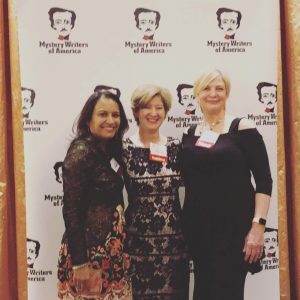
To my right are Mariah Fredericks and Paula Munier
To select the Mary Higgins Clark Award, a judging committee of MWA members reads hundreds of novels that are whittled down to an announced shortlist of usually five or six books. Out of these nominees, a winner is announced at the Edgars dinner.
I was stunned to be nominated for The Samurai’s Daughter in 2004. In 2019, I was again nominated for a book in my new series, The Widows of Malabar Hill, which shared the nomination with books by Mariah Fredericks, Dianne Freeman, Julia Keller and Paula Muncier. Widows turned out to win that night, and I experienced so much surprise and joy that my heroine, Bombay lawyer Perveen Mistry, was now part of the MHC tradition. Mary was not at the Edgar Awards Dinner that night. We missed her.
I wonder what she would have thought, if we’d met. I don’t see myself as being close to MHC in style of writing or structure—and certainly, I lag behind her in productivity and sales. But she might have liked my heroine. A long time ago, I decided to commit to writing books about intelligent women who support themselves and those around them. It just felt natural.
This is how a lot of us go through life. We are sailing along minding our business, and something awful happens. Our crisis could be one of many terrible things: an incident of racism in the neighborhood, a family member’s pain, a financial setback or the news of a friend’s serious illness. We throw ourselves into action and try our best, no matter the outcome.
In the books of Mary Higgins Clark, we see ordinary women saving the universe. Ourselves amplified, everywhere.
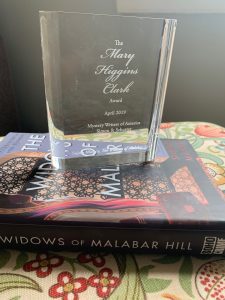
The post Mary Higgins Clark, Speaking for Women appeared first on Sujata Massey.
January 29, 2020
From India with love
This post originally appeared on Murder Is Everywhere.
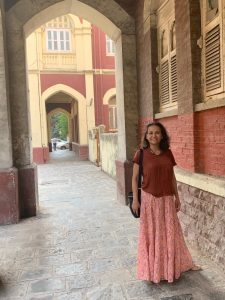
I’m filing this on my last day of a wonderful three weeks in Mumbai.
I was taking a walk through a shady, old-fashioned passageway in a typical 19th century shop building in the Colaba neighborhood. It was a delightful meander just steps from the historic Royal Bombay Yacht Club, where I spent my las few days.
With any trip, there are ups and downs. Over this trip, I haven’t had a moment of stomach trouble. However, I had a laptop fall very ill (and then recover, thanks to the geniuses at Maple Shop, as India’s Apple licensee is called). I switched the places and neighborhoods I was staying in three times and never really had a quiet night. Well, I guess it’s Mumbai, right?
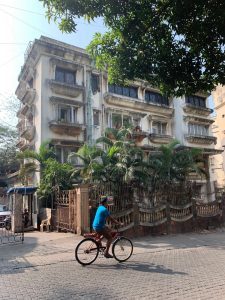
Lovely old flat building in Bandra
I managed 20-plus interviews over this trip; I saw a new film, a popular play about a legendary actress, and a dress rehearsal of another play with a Bollywood connection (more on this one in another post). I attended an Odissi dance debut of a teenage artist. I shopped at a modern art show and filled my eyes with masterpieces of at the Bhau Daji Lad Museum of decorative arts and the Asiatic Society of Mumbai. I attended to a university lecture and was able to chat with students. I visited a historic Parsi colony and several courts of law—one of them the former coroner’s court, which I expected had been swept away since this legal process is no longer a necessity in Bombay. What a thrill to find the high-ceilinged room where cause of death was determined by a jury still exists, albeit filled with cubicles.
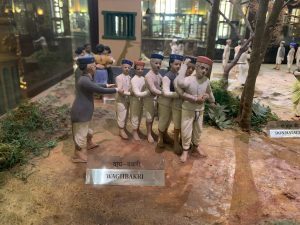
The Bhau Daji Lad museum offers a doll-sized view of history
The one thing I could have done but missed out on was being on set for a Bollywood film shoot. Do I regret not going because it was starting close to midnight?
As I sit in the airport, I admit I should have blinked away my fatigue and gone.
Therefore, I don’t have star photos for you, but in upcoming posts I aim to share what I loved so much about this trip to Mumbai.
And that even in 2020, it’s such a joy to be able to tread through the passageways of the city back to the Indo-Victorian world of my fiction.
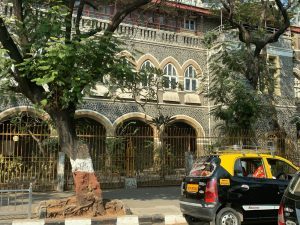
Historic Wilson College is an inspiration for the next Perveen book
Whilst in India, I received the great surprise of a nomination for the 2020 Bruce Alexander award for historical fiction, and the 2020 Sue Grafton Memorial Award for a mystery featuring a female protagonist. The Lefty historical winner will be chosen by conventioneers voting at the Left Coast Crime convention in San Diego this March, and the Grafton award has been chosen by a judging committee and will be announced at the Edgars Dinner in New York in April. I am very excited and grateful that The Satapur Moonstone was enjoyed by both fans at LCC and a committee of professional writers serving as judges for the Edgars. I encourage you to check out the whole Lefty List and the Edgars List for books you might enjoy.
The post From India with love appeared first on Sujata Massey.
December 18, 2019
Sujata’s Writing Road, 2019
This post originally appeared on Murder Is Everywhere.

With debut author Tori Eldridge at Chevalier’s in Los Angeles
I grew up in the age of point-and-shoot simple cameras, which at the time seemed beyond magically simple. But in the last ten years, the cell phone camera has thrown old-fashioned cameras to the curb. We are now responsible for being the chroniclers of our lives.
I feel that stopping what I’m doing to take pictures takes me out of the moment, so I don’t do it a whole lot. But when I travel, or have special friends come my way, I go straight to the camera app on my phone.
Here are some of my favorite moments saved over the last year—my grateful thanks to the invisible assistants who did a lot of the snapping. These pictures remind me how many people—family, writing friends, readers, and booksellers—have brought joy into my work life. I was thrilled to launch the second book in my Perveen Mistry series, The Satapur Moonstone, and humbled by the recognition given to the book before it, The Widows of Malabar Hill. And this made photo-ops!
For all these journeys, and so much more, I am grateful. You may notice a lot of books in these pictures. Whoever guesses the right number deserves their own prize.

Crime Writers of Color founder Kellye Garrett came to my house to make drinks
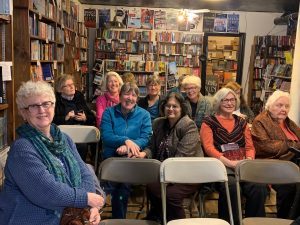
Twin Cities roundup: my stepmom Manju and good friends at Once Upon a Crime
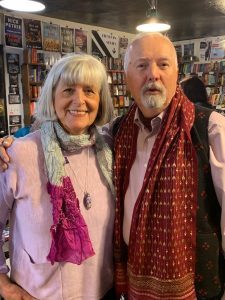
My mother Karin and her longtime pal Don Johnson, an expert on Indian textiles

This was one of the biggest book talks on the tour due to Margaret and Kathy’s efforts

I was having a lonely dinner in Houston before a signing discovered two readers, Tara and Priyanka, were in the same bar!

There was literally a tornado hitting Kansas when I posed with Raven Books’ Danny Caine
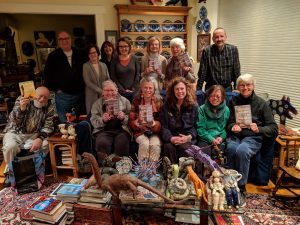
Janet Rudolph’s legendary mystery bookclub read Widows!
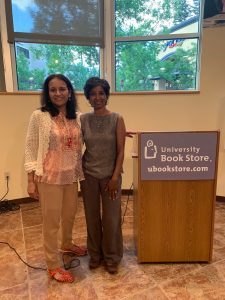
What an honor to have audiobook narrator Sneha Mathan read for me in Seattle

Getting into position for Nancy Pearl’s web talk show, Book Lust
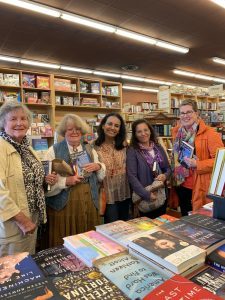
I drove to Santa Barbara for lunch and met a bunch of newsletter subscribers!
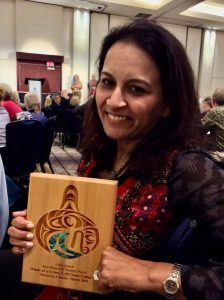
The hand-carved award for Best Historical Mystery at the Left Coast Crime Con
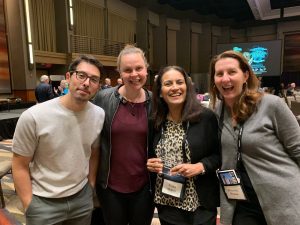
Celebrating the sheer glass Macavity win for Best Historical at Bouchercon with Soho’s Rudy, Juliet and Bronwen

With my husband just before winning the Mary Higgins Clark prize at the Edgars in NY
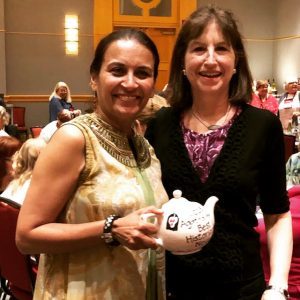
With my agent Vicky Bijur and the Agatha teapot
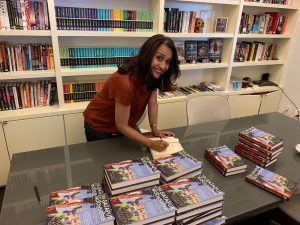
To touch a hot-of-the-press book for the first time is a real thrill!
The post Sujata’s Writing Road, 2019 appeared first on Sujata Massey.
December 5, 2019
Gardening on Deadline
This post originally appeared on Murder Is Everywhere.

For too long, I’ve been lost in the LED-lit, indoor world of writing. Over the last month, I was intent on doing nothing else except finish a book.
It also happened that late November turned out to be the only time to plant a garden. Fall planting is easier on trees and shrubs that will get a good watering all fall and winter. Yes, I had a book due; but the garden also had to be installed, after having been delayed by several months due to Maryland’s unusually dry fall.
The garden and I have been at loggerheads before. My quest to unsettle a little less than an acre of city land began when I moved in with my family during the fall of 2012. The first thing we did was absolutely violent. We hired a company to drill four wells 500 feet deep inside our long, sloping lawn. The racket it made! The ash that spewed into the neighborhood air! The sky looked so gray over our street that somebody called the fire department.
Ah, the geothermal wells. They make it possible to have a modern air conditioning system where the air passes over the cold water, deep in the ground, and returns to the house. No chemicals, no excessive use of electricity.
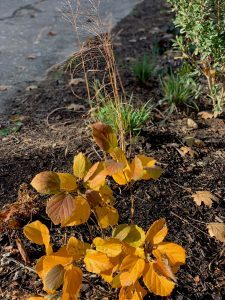
From almost the start, our land has served us. But it has always been scraggly around the edges. Every spring I would be filled with inspiration that would trickle away about the time the mosquitoes settled in for feasting at the end of June. I wanted a garden full of native plants to support wildlife and suppress weeds. But how? The longer I fretted, the more the weeds spread.

Three years ago, I dug a small front garden myself with native plants, but it was such a hodgepodge without coherent flow that I wanted more assistance the next time I tried an improvement. This fall, I felt blessed to be aided by a native gardening education consultant/garden artist/all-around genius. Kay McConnell is well known in Maryland for the beautiful native plant gardens she designed and installed at the Friends School of Baltimore, Stony Run Meeting, and other spots.

Under Kay’s eagle eye, a weed-filled stretch running along the back of the property was cleared in late August as the site of our future rain garden. The clearing and regrading of the earths was done by strong men driving big machines. The new space they created wasn’t flat smooth dirt, but two raised banks surrounding a long basin. This would catch water that ran down our sloping lawn toward the lane. The saved water would feed the kind of plants like native iris and milkweed that like their feet wet.
As the dry fall turned into a rainy November, the prepared, empty garden space slowly became wet. Kay rooted through her native plant stock and area nurseries, looking for the best shrubs, trees, grasses and native perennials. A willow, magnolias and dogwoods were found, along with itea, bayberry, buttonbush, various ferns, swamp milkweed, oak leaf hydrangea…

The list went on. Over several days in late November, Kay unloaded shrubs and flowering plants and grasses from her car. The trees came in with European Landscapes and Design, the company that had done the original garden clean-up and preparation.

I recently heard a few different people use the phrase: “We go big, or we go home.” It’s a 2019 cliché. However, I could not deny that things were getting very big, right at my home.
I was thrilled to realize that every single tree, grass and shrub would feed local birds and insects. The garden design has woodland, meadow and swamp sections, with everything flowing together in an artistic manner, with fields of color, and high and low points. I found myself spellbound watching Kay. She is a true artist in the garden, arranging plants and rearranging them as the visual flow becomes apparent to her.

As I worked under Kay’s direction, I learned so much. She taught me how to plant a natural looking drift of small flowers. I absorbed the new thinking on weed control: don’t tug them out, which disrupts the earth and activates weed seeds. Instead, cut them close to the ground to weaken the plant.

I saw, through her eyes, how an aged stretch of asphalt pavers could become a dining terrace or site for a fire-pit gathering spot. And as my neighbors strolled along the lane that runs on the other side of the new garden, they had plenty to say. Michael, after visiting with us a few times, commented that he felt that spirits had entered the garden that were never there before.

And that’s how writing works, too. A bulky stone is chipped away to reveal the story hiding within. It takes time, but it’s always waiting for you.
And the thing about gardening deadlines is that the only one that really matters is set by nature. One can’t dig after the ground is frozen—unless, perhaps, you have a geothermal drill.
And putting a plant into earth does not guarantee it will emerge in the spring. That is the mystery I’m entering.
The post Gardening on Deadline appeared first on Sujata Massey.
November 7, 2019
Bouchercon 2019: Texas Welcome
This post originally appeared on Murder Is Everywhere.
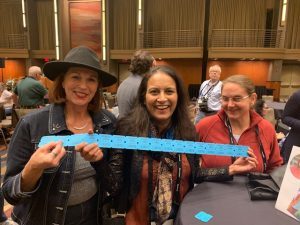
I went to Dallas last weekend for Bouchercon, a 50-years-old-and-counting annual mystery convention. The weather was cold, yet the Texans were warm. So were the folks I chatted with among the flood of 1800 mystery lovers who arrived from all points. This year’s theme was suited to conventional thinking about Dallas: Diamonds, Denim and Death!
Every day was filled with book talk. This was done on panels, in the book room, the bar, the hallways. I met people from as far as Israel and India, and as close as Indianapolis. I met so many new friends that I hope to see again.
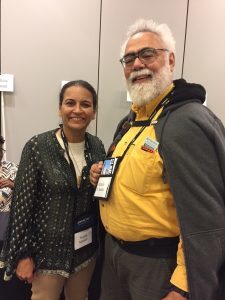
Retired diplomat Alfredo Barela knows me through Rei Shimura

Soho’s publisher Bronwen Hruska with author Francine Mathews
Even though Bouchercon is ostensibly about attending panels of crime novelists and publishing professionals, there are many side parties and special activities. Soho Press, my publisher, specializes in mysteries by authors from around the world, and they threw a special reception for author Peter Lovesey, who was celebrating the eighteenth adventure of his brilliant police detective, Superintendent Peter Diamond. I tore almost one hundred raffle tickets for people wanting the Diamond book bonanza. This was another slick way to make friends.
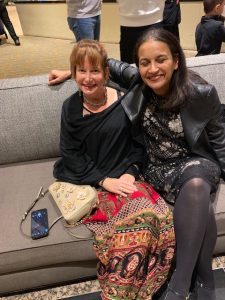
Being charmed by author Teresa Dovalpage
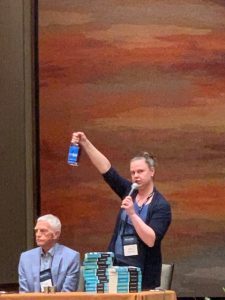
Peter Lovesey’s grand giveaway being awarded by our editor Juliet Grames

With the Soho publishing gang
I feel so much at home with a publisher like Soho, who is enthusiastically committed to publishing great fiction with characters who are diverse in national backgrounds—and not sprinkled in for color, but because they are compelling people and their stories are unforgettable. At the Soho International Guest of Honor party, Peter Lovesey announced a new Soho contest for first-time authors with a paid advance and publication. He got his start with a literary contest in England, and that’s similar to how I broke into print (the Malice Domestic Unpublished Writers Grant Contest).
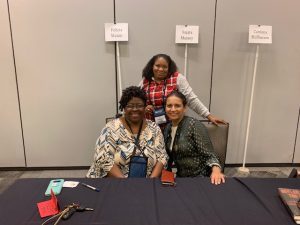
Loved signing near author Felicia Mason and cinematographer Semone
When I began going to Bouchercon in 1996, the majority attendance was white men. Gender dominated the atmosphere in the bar and in the pale rooms. For the most part, Bouchercon no longer has that feeling of an old boy network. The con feels like a place for many people to express what it is they bring to mystery or love about it. I hear about mystery book groups, field research in New Zealand, and secret hikes into off-limit areas. Also crafts, quilts, and cocktail recipes.

Anthony noms for Kellye Garrett, Lori-Rader Day, James W. Ziskin, Holly West
In addition to panels where we can learn the secrets behind beloved books, the convention is also a haven for awards ceremonies. The convention bestows a fan-voted prize called the Anthony, which is named after the inspiration of the convention, the late New York Times book critic Anthony Boucher, said to be the first journalist who treated mystery fiction as serious literary works. Other mystery-centric organizations like Mystery Readers International give out the Macavity awards for general mystery fiction, and the Private Eye Writers of America awards the Shamus awards for professional investigator novels and stories. The Barry and the Dillinger are also coveted awards at Bouchercon. But that’s not enough for Bouchercon. Its organizers also shower honors on booksellers, fans, and other special people who have built the power of mystery fiction. The overall theme is love and thanks for keeping our literary world booming.

S.A. Cosby, Anthony Winner
If you go to enough conventions, you may no longer wear a size six little black dress, but there are some sizable advantages. Being an old-timer means you can enjoy seeing friends and newcomers light up as they receive their first requests for books to be signed, and maybe even awards for them. This year brought a special thrill when my friend Shawn (S.A. Cosby), whose first novel comes out next year with Forge, won the Anthony for best short story. He had moved me to tears a few nights earlier reading this prize winning story, The Grass Beneath My Feet, aloud in the hotel bar.
Yes. Only with mystery lovers, is there read-aloud story time in bars.
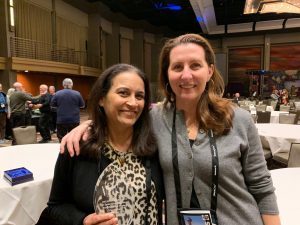
Holding the Mcavity tight to my heart with Soho’s publisher, Bronwen Hruska
On Halloween night itself, I was humbled to win the Macavity Award for The Widows of Malabar Hill. It turned out to be a beautiful crystal keepsake that will be take pride of place alongside a fabric Macavity cat award I won many years ago for The Flower Master. The nominees in this category were so excellent, I think any one of us could have won. So I am especially grateful, following the amazing awards this book has already gathered.
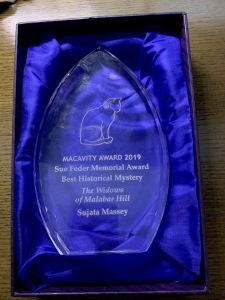
I was also nominated for a Shamus award given by the Private Eye Writers of America. I was very surprised that Perveen Mistry was seen as fitting into this category—she’s a legal investigator, not a gumshoe. I hardly minded losing to Kristen Lepionka, who wrote a great modern PI novel featuring a woman, What You Want To See.
At the Shamus awards dinner, some words were casually said that led to many follow-up dialogs on Facebook and Twitter about how we can welcome people we don’t know well into our various tight-knit mystery worlds. Some of the conversations were quite heated, while others were healing. Anyway, it wasn’t until a few days after I got home that I could put away this other baggage, too.
When the new books go on the shelf, the old suitcase returns to the attic, and the wrinkled receipts go to the tax box, I no longer have visions of diamonds, denim and death.
It’s time to stop chatting and start writing again.
The post Bouchercon 2019: Texas Welcome appeared first on Sujata Massey.
November 5, 2019
A statement from Sujata Massey
Of course, I will accept Max Allan Collins’ apology for his comments at the 2019 Shamus Awards. Max says he did not intend emotional harm to any particular person or persons, and I believe him. And it is important to remember from this “kerfuffle,” as Max described it, that language is powerful.
Singling out a subgroup of award-nominated writers as foreigners carries a message of otherness, especially when the PWA membership is so heavily white male. We all need to listen if someone comes up to privately share about how they interpreted our language. We should also be willing apologize to such truth tellers if we have dismissed them in the moment.
I’m extraordinarily grateful for the valiant colleague who spoke up after the Shamus dinner—and thankful to all of you, my dear friends, for standing up yesterday and today in defense of diverse mystery writers.
I am also very happy that Kristen Lepionka won a Shamus award for WHAT YOU WANT TO SEE in our shared category of best novel. And to all the other winners and nominees: you are awesome, and I want you to enjoy your success, too.
The post A statement from Sujata Massey appeared first on Sujata Massey.



